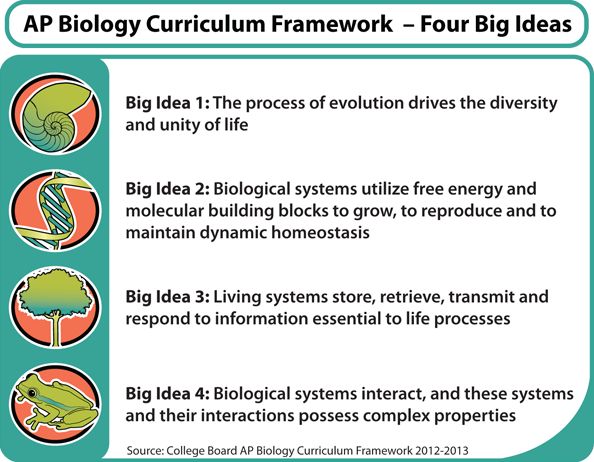The study of biology reveals a tapestry of intricacies that govern life on Earth. For students engaging with the Advanced Placement (AP) Biology curriculum, it is imperative to grasp the foundational concepts that underlie this vast field. Central to this educational endeavor are the “4 Big Ideas” of AP Biology, which serve as pillars for understanding the biological sciences. These concepts not only foster critical thinking but also equip students with the analytical tools required to navigate the complexities of living systems. This article will delve into each of these ideas, challenging students to ponder: How do these overarching themes connect to the myriad of biological phenomena that exist in our world?
Big Idea 1: The Process of Evolution Drives the Diversity and Unity of Life
At the heart of biology lies the unifying concept of evolution. This big idea posits that through processes such as natural selection, genetic drift, and gene flow, populations of organisms undergo gradual changes over time, leading to the incredible diversity we observe today. The notion that all life shares a common ancestry ignites curiosity about the connections between disparate species. How do evolutionary mechanisms shape adaptations in organisms, from the beaks of finches to the camouflage patterns of cephalopods?
Students exploring this big idea should contemplate examples of evolutionary processes at both macroscopic and microscopic levels. Consider the evolutionary pressures faced by antibiotic-resistant bacteria. Such scenarios illuminate the importance of understanding evolution, as it informs medical practices and public health policies. Engaging with evolutionary theory is not merely an academic exercise; it poses real-world implications in combatting emerging diseases and fostering sustainable ecosystems.
Big Idea 2: Biological Systems Utilize Free Energy and Molecular Building Blocks to Grow, Reproduce, and Maintain Homeostasis
This concept emphasizes the critical role of energy transfer and molecular interactions in sustaining life. From the photosynthetic processes in plants to cellular respiration in animals, organisms harness energy to power the metabolic activities essential for survival. Central to this big idea is the notion of homeostasis—the ability to maintain stable internal conditions despite external fluctuations.
Students must grapple with questions such as: What forces drive metabolic pathways, and how do they contribute to the overall functioning of an organism? Delving into thermodynamics, particularly the first and second laws, provides insight into energy flow and transformation. The examination of molecular building blocks, including nucleic acids, proteins, and lipids, reveals the biochemical intricacies that enable life to flourish. Encouraging students to consider homeostasis fosters a greater appreciation for the delicate balance necessary for survival in diverse environments.
Big Idea 3: Living Systems Store, Retrieve, Transmit, and Respond to Information Essential to Life Processes
Information is fundamental to biological processes, encapsulated within the genetic code of organisms. This big idea encompasses the mechanisms by which cells communicate, respond to stimuli, and replicate genetic material. The interplay between environmental cues and genetic information illustrates how organisms adapt to their surroundings. Consider the complex signaling pathways that enable cells to respond to hormonal changes; this interaction is vital for regulating growth, development, and reproductive cycles.
Students should contemplate the implications of advancements in genetic engineering and biotechnology. How does our understanding of DNA and its regulatory mechanisms allow for innovations in fields such as medicine and agriculture? By investigating these questions, learners can appreciate the transformative impact of genetic information on a global scale. The challenges posed by ethical considerations in genetic manipulation further emphasize the significance of comprehending biological information flow.
Big Idea 4: Biological Systems Interact, and These Interactions Possess Complex Properties
The interconnectedness of biological systems underscores this final big idea. Ecosystems, cellular networks, and physiological systems exemplify complex interactions among various components. These interactions often yield emergent properties that cannot be understood by examining individual parts in isolation. The study of ecology, for instance, invites students to explore relationships between organisms and their environments, raising intriguing questions: How do predator-prey dynamics influence population stability? What roles do keystone species play in shaping community structure?
Moreover, interactions at the cellular level reveal the intricacies of homeostatic processes. Signaling pathways, enzymatic reactions, and feedback loops highlight the delicate balance that sustains life. By investigating these multifaceted relationships, students gain insights into the resilience and adaptability of biological systems. Recognizing the complexity of life processes fosters a holistic understanding essential for addressing environmental challenges and promoting biodiversity conservation.
In conclusion, mastering the 4 Big Ideas of AP Biology equips students not only with a robust foundational framework for understanding biological processes but also instills critical thinking skills essential for navigating the complexities of life. As students engage with these concepts, they should continually question and explore how these themes interconnect within the tapestry of life. The journey through AP Biology is not confined to memorizing facts; it is an intellectual adventure that encourages curiosity, critical analysis, and a deeper appreciation for the wonders of the biological world.
